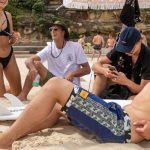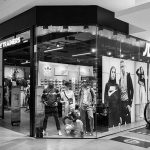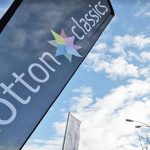Lesson One in trying to kill the golden goose trade show-make the show so big that you have to trek all over town and then shoo away all the retailers with bad timing. Blow into a balloon long enough and it will pop!
That was the feeling as the exhibitors at last weeks WSA (World Shoe Association) Show played to empty aisles and two venues at opposite ends of the Las Vegas Strip.
Attendance at the show was clearly down from previous events, with the Saturday through Tuesday format, and the split venue at the Sands Convention Center and the new Mandalay Bay Convention Center, cited as the main reasons for the decrease in traffic.
Most vendors we spoke with did say that the weekend was filled with “quality” appointments and they saw all the big guys they expected to see, but the lack of the smaller independent and Mom n Pop retailers left the aisles a bit empty.
The cost of show attendance and the prospect of leaving the shop over the weekend (not to mention heightened terror alerts) were seen as the main culprits for the lack of the smaller guys. And lets face it, theres a lot fewer of them these days as well.
The athletic area at the Sands was again the bright spot as we saw good energy around the booths, even though much of that traffic was due to sales reps and excess company personnel spilling out into the aisles. Reebok was the center of much of the buzz, but it primarily centered around the continuous airing of the Terry Tate ads. RBK sales personnel were giddy with excitement as they watched the ads — over and over throughout the weekend-that signaled their return to a strong marketing message.
Unfortunately, as you got further back off the main thoroughfare in athletic, it got a lot rougher. Key brands like Asics, Vans and Airwalk saw aisle traffic disappear altogether as they relied on their strong appointment books to keep the booths busy over the weekend.
Day three (Monday) was a ghost town as the “quality” guys left to be back in the office to review the week – and executives from many of the exhibiting companies following suit.
The placement of the fashion brands at Mandalay Bay at the end of the strip was not well thought out. The travel time between the two venues took at best 30 minutes and at worst 1 1/2 hours. You certainly didnt try to do it more than once a day. As we reported from the SIA Show, the Mandalay facility was dramatically better than the Sands, but it was tough to get to if you were based at the Venetian or Harrahs.
One vendor speculated that at any one time 10% of the buyers were in transit between venues.
The mega brands at Mandalay had such large booths that it appeared that no one was even in the hall. Many aisles were completely devoid of traffic, even as key customers filled booths. Skechers “Vegas Review” fashion show attracted good crowds and provided the only real excitement at Mandalay.
WSA is reportedly married to the Sands facility until 2005, but we can only hope they can find a way to get the whole show in the new facility ASAP.
>>> SIA showed the industry that a smaller booth show can be more intimate and create more energy than the sprawling format WSA provided. Show planners could take a lesson here.
Retailers remained very cautious in the face of impending war and a weak global economy. Most retailers we spoke with felt the show provided nothing new in terms of items, brands or trends to simulate new business. Current business is still very tough for everyone except the recipients of additional Nike allocated products.
Hot brands on the show floor were Puma, New Balance and K-Swiss. Nike, Converse and adidas maintained their suite positions at the Venetian. There were no emerging or new brands in the athletic arena. No attempt was made to highlight or encourage new lines or brands.
We spoke with a number of companies that are bringing Euro influence to the states with color and silhouette. The real question here is how to educate the retailers on how to present this fashion product. Plexi shelves on a vast shoe wall are not the way to merchandise this emerging category.
>>> Will the athletic retailers have the skill set to execute this change? Will they take it off the wall and put it on tables? Will retailers accustomed to buying and selling by category really get the message about selling by collection?
We saw some terrific product under the Vans “Vault” collection, a tightly controlled range offered to the Fred Segals and Barneys of the world. Some hand-painted product will only be produced in 36 pair runs and will reportedly retail for $250.
The major trend in many booths was to nibble at some of the Puma business even as Puma dug deeper into its own vault to push the envelope even further. The Motorsports category is now the hottest category for Puma in Europe and much of that influence was seen in the new product. Silhouettes that harken back to the turn of the century-1900, not 2000 — were the most unique thing we saw. Not much volume, but they certainly keep Puma in the leadership spot on design and trend.
Many brands are definitely going after Pumas limited distribution, with some execs we spoke with pointing to the strategy as too limiting in the face of trying to build a broader brand.
These brands are developing product using some of the same influences, but are expected to open distribution a bit more. That should kill that goose as well.
Closeouts seemed to be at a minimum, as manufacturers have done a much better job of anticipating the soft patch we are in. And some need all the closeouts they can get to keep their own retail stores filled.
Skechers was reportedly wheeling and dealing with much heavier at-once inventory on the floor than at shows past. SKX was also rumored to be offering deep show discounts on Q3 product to bolster the order book. They pulled much of January forward to make the 2002 numbers.
The wild-eyed merger rumors that were flying at Super Show seemed to have died down a bit. The TSA/Gart marriage surfaced again, but without much enthusiasm.
Rumors of Ponys sale to Killick Dattas GBMI was probably the hottest story, with the deal reportedly closing March 1st. The Firm, the current owner of the brand, will reportedly be able to focus on what it does best as it retains marketing for the brand. Pony partner ACI would be out of any future deal.
Pony reps have already been given their walking papers in anticipation of the deal, leaving the booth empty for the show. Current GBMI Mecca reps are expected to carry the Pony line.
The other brewing story in the aisles was the revelation that Nike may be under investigation for price fixing by the Florida Attorney General office. The AG is contacting Florida retailers in efforts to uncover possible anti-competitive efforts by Nike to maintain retail pricing.
Nike officials contacted by SEW late in the week issued the following statement:
“We did receive an antitrust civil investigative demand notice from the Florida Attorney General’s Office. We have cooperated fully in their investigation and have provided them with all the information they requested. We do not believe at this point there are any substantial issues.”
The action is not unlike the issue Reebok had in the early nineties with the FTC for violations stemming from its ill-fated Centennial program. The repercussions are still felt in RBKs Canton headquarters and has led RBK sales management to be less than aggressive at times in pursuing brand purity and pricing integrity. They were never able to work on a level field with NKE after the feds slapped them with the suit.
>>> It was only a matter of time before someone started sniffing around this issue. This is just the kind of action that can take some wind out of NKE brand initiatives as lower tier retailers feel emboldened to go after NKE for past perceived indiscretions. RBK is still looking over its shoulder…
The buzz around the New Balance booth centered around the action by Reebok to prevent former RBK account manager Billy Scheidler from representing New Balance at Finish Line. “Scheids” called on Sears for many years. Reebok invoked a non-compete clause in the agreement employees are expected to sign as a condition to employment and receive options.
>>> Should do wonders for recruitment.
Across the aisle at Puma, former Reebok RVP and 80s Carolina agency head, Al Tunstall, made his debut as the new head rep for Puma in the Southeast. The reincarnation of Sports Ventures, Inc. was able to retain all agents from Pumas SE agency previously led by John Militano and has added additional reps in key spots. Militano has moved to New York to handle Pumas Foot Locker business and be closer to family.
Another RBK alum, Helene Cohen, is now at Timberland managing the brand for Department Stores in SoCal. Helene handled May Co. and Nordys for RBK.
Former FUBU footwear sales & marketing gurus Trevor Delmore and Courtney Delmore were seen at Stride Rites Tommy Hilfiger Footwear. The pair have started an agency and will handle the fashion footwear brand in the Northeast.
Also getting into the rep game, former Global Sports GMM Glenn Walls launched Trilogy Sports to represent Asics in the New York Metro market.
>>> These moves are seen as a new trend in the industry as brands look to upgrade their sales organizations from sales reps to “business managers”. The tight labor market at the management level provides new access to some very talented people to run increasingly complex businesses
Former Reebok, Fila and GBMI sales and product tactician Mike Longo is now at Sole City, Inc. helping build the U.S. Polo Footwear business for Sammy Safdeyes NYC-based company. Sole City also has licenses for Avirex and Troop.
U.S. Polo Footwear is expected to follow the lead of the apparel companys distribution strategy, focusing its efforts in the mid-market arena. Longo said they have taken an “upscale approach to the mid-market business” as more retailers in that channel look to upgrade their casual and athletic-inspired footwear offerings.
The brand, priced in the $19.99-$69.99 range has already found a home at Modells, TSA, Shoe Show and Mervyns. Obvious targets are Famous Footwear, Rack Room, Kohls and JC Penney.
Former Reebok apparel sales manager Cliff Lelonek and lieutenant Jim Ryan are credited with re-focusing the U.S. Polo Association brand away from less credible channels and focusing on the mid tier.
nuff for now, on to Magic…















